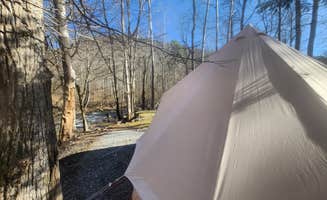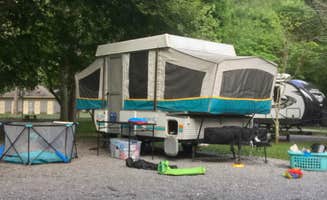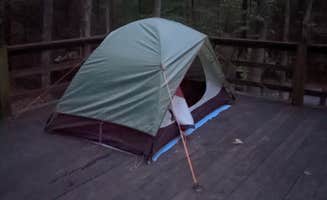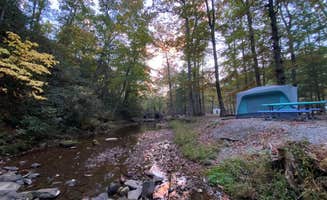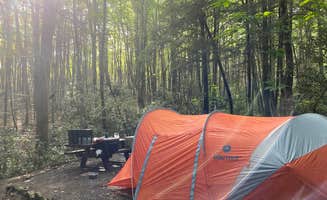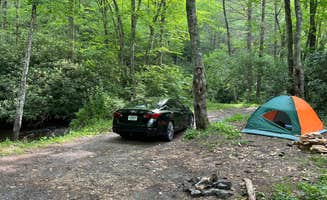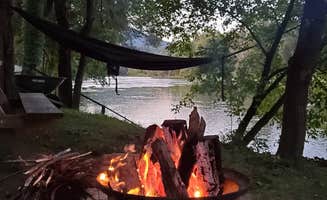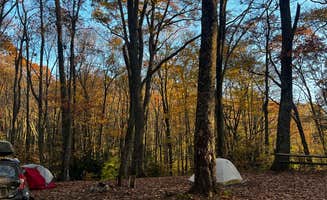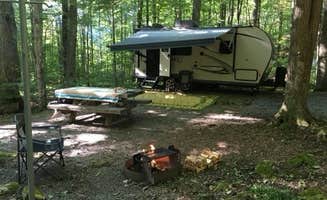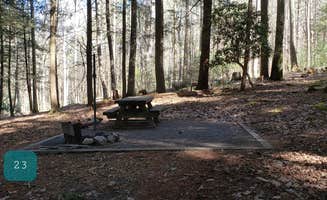The camping areas near Saltville, Virginia range in elevation from 1,800 to 5,700 feet, creating distinct microclimates that affect camping conditions throughout the year. Many sites in the higher elevations can be 10-15 degrees cooler than valley locations even during summer months. Forest Service roads accessing dispersed camping often require high-clearance vehicles, particularly after rainfall.
What to do
Trout fishing opportunities: Rainbow Campground provides direct access to stocked waters. "An amazing Campground, and area! This is early March with decent water levels, The Roar of the creek at the base of the campground is very therapeutic. They stock the creek twice a month with trout, it was stocked 80 ft from my tent 2 days ago..." reports one camper at Rainbow Campground.
Paddle sports on mountain lakes: Beartree Campground offers calm waters for beginners. "We use the lake for paddle boarding or kayaking and we bike on the Va Creeper trail, the local mountain bike and hiking trails adjacent to the campground or just bike down to the lake and back," describes a frequent visitor to this quiet recreation area.
Wildlife viewing beyond ponies: While wild ponies are a major attraction at Grayson Highlands, Hurricane Campground provides different wildlife encounters. "We stayed 2 nights but would have liked to stay longer. Really good access to the AT, we saw no one for 6 miles except a bear," shares a hiker who explored the remote trails from Hurricane Campground.
What campers like
Therapeutic water sounds: Multiple campsites near Saltville feature creekside locations that provide natural white noise. At Washington & Jefferson National Forest Dispersed Sites, campers appreciate the natural soundscape: "Overall this was a great little spot right off the road. The sound of the creek was lovely all night."
Digital disconnection: The lack of connectivity creates an authentic wilderness experience in many areas. "You are truly away at Beartree," explains one reviewer about Beartree Campground. "There is absolutely no cell service at this camp, you have to go into town or hike a local mountain to get service up high," reports another camper about dispersed sites.
Site privacy through natural features: Many campgrounds use landscape elements for separation. "The sites were built in a forest of rhododendron and there is so much privacy compared to most other campgrounds. As a result, it seems quieter," notes a long-time visitor to Beartree Campground.
What you should know
Weather unpredictability: Mountain elevations experience rapid condition changes. "Weather is unpredictable, so pack a raincoat and warm clothes just in case," advises a visitor to Grayson Highlands.
Seasonal variations in facilities: Most campgrounds reduce services during cooler months. "We were there the first day the campground opened and it filled quickly. You'll definitely want reservations for a weekend stay," warns a camper at Hickory Ridge Campground.
Road challenges: Access to more remote sites often requires preparation. "I took 650 from the north west, which turns out to be a 4 mile stretch of gravel road - which my little car had a rough time handling," cautions a visitor to Hurricane Campground.
Firewood and water sources: Services vary significantly between established and dispersed sites. "There is no drinking water, picnic tables, or even pit toilet, so come prepared," explains a camper regarding Washington & Jefferson National Forest dispersed sites.
Tips for camping with families
Playground access: Some campgrounds offer dedicated play areas. "There is a nice area for a picnic with swings and other things for kids," notes a visitor to Riverside Campground.
Swimming options for different ages: Water features vary in depth and safety. "The river is perfect! It's not too deep so the kids can play in it. Fairly easily accessed from many areas at the campground," explains a family that enjoyed Riverside Campground.
Educational opportunities: Historical and natural features provide learning experiences. "Plenty to keep kids and adults alike entertained, whether it's exploring the homestead area, looking for ponies, taking short hikes, geocaching, or playing games on the open field area," suggests a reviewer about Hickory Ridge Campground.
Tips from RVers
Site positioning considerations: Some campgrounds offer better RV-friendly options than others. "Even-numbered hookup sites 60-70 are also right on the meadow with very little shade," notes a visitor to Hickory Ridge Campground regarding site selection.
Tree clearance challenges: Vegetation can create hazards for larger vehicles. "The only problem we had were that some of the trees need to be trimmed back and scratched the upper sides of our coach," cautions an RV owner at Camp Burson.
Road navigation warnings: Access routes may present difficulties for larger rigs. "The road in is steep, winding and has a very sharp turn. I made it with 38' RV with toad," reports a Camp Burson visitor, providing valuable insight for those with larger vehicles.


